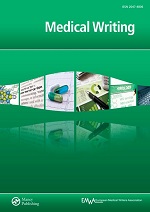

For most of us, medical writing is highly technical. We prepare regulatory or clinical documents or write materials targeted to medical doctors. Medical writing for lay audiences is different, and it does not come naturally to most of us because we are often locked into our specialties and specialised way of writing. What's more, most of us started our careers as scientists. Joyce Salita explains that scientists (and therefore most medical writers) face a variety of challenges in writing for lay audiences.
Writing patient education materials, for example, requires a skillset unusual for most medical writers. Stella Hart describes that writers preparing patient education materials need to be able to empathise with the patient's experience, ask interactive questions, and write in a way that is appropriate for their audience's literacy level. This touches on issues of readability and ‘health literacy’, and it means that the writer must be able to explain complex medical issues in a way that can help patients make choices related to prevention and treatment – not an easy task.
Writing for lay audiences is also increasing relevant for regulatory writers. According to Lisa Chamberlain James, there has been ‘a paradigm shift in the pharmaceutical industry and regulatory agencies towards transparency and an emphasis on the benefit-risk ratio of medicines’. Risk management plan (RMP) Section VI.2, established in 2013, and Regulation EU 536/2014 require regulatory writers to prepare lay summaries and explain risk-benefit to lay audiences in a way that avoids bias and confusion. As pointed out in Lisa's article and a second article by Kerstin Prechtel and Stefanie Rechtsteiner, the RMP legislation creates an enormous challenge because it requires submission of a public summary that must simultaneously be understood by regulators, industry, healthcare professionals, and patients; must be medically accurate; and must convey all relevant information needed for a medicine's authorisation. In addition, as described by Claire Gillow, recent EU legislation also requires that a layperson summary accompany clinical trial summaries – even though regulatory guidance is not yet available.
Regulatory writers are also called on to prepare package leaflets. The legislation and template for the preparation of patient leaflets have been around for more than 15 years, but Antoinette Fage-Butler explains that they have not necessarily simplified the task of preparing these materials. She advocates replacing the template with a set of recommendations that allows regulatory writers greater freedom to respond to patients’ needs.
With the different skills needed to write for lay audiences (not to mention the evolving requirements and guidelines), how can a medical writer feel confident that the documents they write for lay audiences are understood and accomplish their objectives? One answer is user testing, in which feedback from test users is used to improve the quality of educational materials. Theo Raynor and colleagues describe their experience in employing user testing to test and improve not only information for patients but also information for professionals and other audiences.
For those medical writers who already have a knack for lay writing, medical journalism might be attractive. Jo Whelan describes medical journalism and how a medical writer might find work, and Sonya Collins describes how elements of storytelling are used in medical journalism. Finally, Stevan Mijomanović and Sofija Mićić Kandijaš discuss medical blogs, an extension of medical journalism and an increasingly popular way of communicating medical information.
A new look for 2016
In 2011, the EMWA journal had its name changed from The Write Stuff to Medical Writing. This was part of a move to a professional journal publisher. However, since making the switch, we have received many comments expressing a desire for a less academic look and layout. This desire was confirmed by responses to a survey this last summer. A less academic look better fits our focus on practically useful information rather than academic-style research. I am happy to report that starting with the first issue of 2016, we will have a new, friendlier look. Other positive changes are afoot, so stay tuned.

 Download the full article
Download the full article
Search
Articles
Links
Editoral Board
Editor-in-Chief
Co-Editors
Managing Editor
Victoria White
Associate Editors
Section Editors
AI/Automation
Biotechnology
Digital Communication
EMWA News
Gained in Translation
Getting Your Foot in the Door
Good Writing Practice
In the Bookstores
Publications
Medical Communications/Writing for Patients
Medical Devices
My First Medical Writing
News from the EMA
Freelancing
Pharmacovigilance
Regulatory Matters
Regulatory Public Disclosure
Teaching Medical Writing
Louisa Ludwig-Begall / Sarah Kabani
The Crofter: Sustainable Communications
Veterinary Writing
Editors Emeritus
Layout Designer
Chris Monk
 Visit the EMWA website
Visit the EMWA website